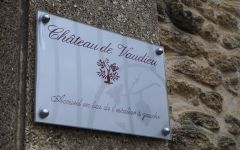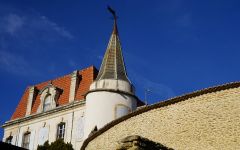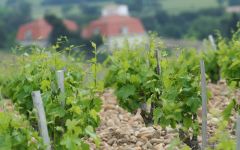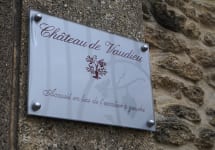Chateau de Vaudieu Chateauneuf-du-Pape Amiral G 2017
-
Jeb
Dunnuck -
Robert
Parker -
Wine
Spectator



Product Details
Your Rating
Somm Note
Winemaker Notes
Amiral G is named in honor of the man was responsible for the construction on Château de Vaudieu in 1767, Amiral Jean-Jacques de Gérin. It is sourced from a parcel of old vine Grenache planted at a high point of a plateau of galets and red clay soils located northwest of the château. Harvested by hand, this Grenache is destemmed and fermented in tronconic concrete vats followed by aging in 600L French oak demi-muids.
Professional Ratings
-
Jeb Dunnuck
The 2017 Châteauneuf Du Pape Amiral G. is, as always, all Grenache brought up all in demi-muids. It's unquestionably the most opulent, sexy, and expansive in the lineup, with overflowing notes of kirsch and blackberry fruits, incense, dried garrigue, and spice, full body, and no hard edges. Its incredible opulence and decadence are delivered with no sensation of weight or heaviness. This magical, thrilling beauty needs to be tasted to be believed. It's going to benefit from short-term cellaring and keep for 15+ years or more.
-
Robert Parker's Wine Advocate
Like the l'Avenue, the 2017 Chateauneuf du Pape Amiral G is 100% Grenache aged in demi-muids. Unlike the l'Avenue, the Amiral G is more about opulence and power. It's full-bodied, ripe and plush, with impressive layers of black cherries, stone fruit, licorice and chocolate spice cake. Concentrated and chewy on the finish, it has all the ingredients for greatness—and it should get there relatively quickly, then drink well for at least a decade. Tasted twice (once blind), with consistent notes.
-
Wine Spectator
This is brimming with alluring fruit, as creamed boysenberry, blackberry and plum notes cruise through, inlaid with anise, black tea and mineral details. The long finish echoes with fruit and a light shiso leaf accent. Offers a gorgeous mouthfeel. Very hedonistic. Best from 2021 through 2035.
Other Vintages
2019-
Jeb
Dunnuck -
Wine
Spectator -
Robert
Parker
-
Jeb
Dunnuck -
Wine
Spectator -
Robert
Parker
-
Jeb
Dunnuck -
Wine
Spectator -
Robert
Parker - Decanter
-
Wine
Spectator -
Jeb
Dunnuck -
Robert
Parker
-
Robert
Parker







Located about a five minute drive outside the village of Chateauneuf-du-Pape along the road which leads to Courthezon you will find Chateau de Vaudieu. It is one of three 18th century Chateaux located in the appellation, tucked into a small valley surrounded by hills and plateau. It is at the intersection of several major terroirs: sandy soils to the north, along a border it shares with Chateau Rayas (one of the best wines in Chateauneuf-du-Pape but not actually a Chateau), pale limestone and clays centered around a forested hillock, and two large plateaux of the somewhat overexposed galets. In total there are 70 hectares within one contiguous estate – something very rare in the appellation.

With bold fruit flavors and accents of sweet spice, Grenache, Syrah and Mourvèdre form the base of the classic Rhône Red Blend, while Carignan, Cinsault and Counoise often come in to play. Though they originated from France’s southern Rhône Valley, with some creative interpretation, Rhône blends have also become popular in other countries. Somm Secret—Putting their own local spin on the Rhône Red Blend, those from Priorat often include Merlot and Cabernet Sauvignon. In California, it is not uncommon to see Petite Sirah make an appearance.

Famous for its full-bodied, seductive and spicy reds with flavor and aroma characteristics reminiscent of black cherry, baked raspberry, garrigue, olive tapenade, lavender and baking spice, Châteauneuf-du-Pape is the leading sub-appellation of the southern Rhône River Valley. Large pebbles resembling river rocks, called "galets" in French, dominate most of the terrain. The stones hold heat and reflect it back up to the low-lying gobelet-trained vines. Though the galets are typical, they are not prominent in every vineyard. Chateau Rayas is the most obvious deviation with very sandy soil.
According to law, eighteen grape varieties are allowed in Châteauneuf-du-Pape and most wines are blends of some mix of these. For reds, Grenache is the star player with Mourvedre and Syrah coming typically second. Others used include Cinsault, Counoise and occasionally Muscardin, Vaccarèse, Picquepoul Noir and Terret Noir.
Only about 6-7% of wine from Châteauneuf-du-Pape is white wine. Blends and single-varietal bottlings are typically based on the soft and floral Grenache Blanc but Clairette, Bourboulenc and Roussanne are grown with some significance.
The wine of Chateauneuf-du-Pape takes its name from the relocation of the papal court to Avignon. The lore says that after moving in 1309, Pope Clément V (after whom Chateau Pape-Clément in Pessac-Léognan is named) ordered that vines were planted. But it was actually his successor, John XXII, who established the vineyards. The name however, Chateauneuf-du-Pape, translated as "the pope's new castle," didn’t really stick until the 19th century.
